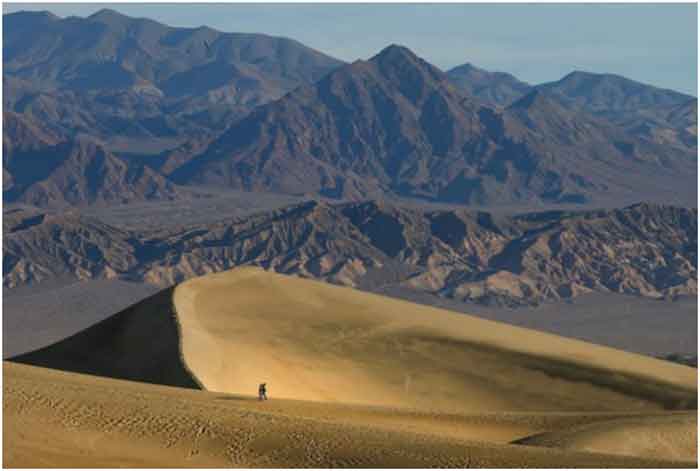
Mesquite Flat Sand Dunes in Death Valley National Park.
Temperatures in Death Valley in the U.S. skyrocketed to a blistering 130°F (54.4-degree Celsius) on Sunday. Possibly, it is the highest mercury reading on Earth since 1913.
If the National Weather Service’s recording is correct, it would also be among the top-three highest temperatures to have ever been measured in Death Valley, as well as the highest temperature ever seen there during the month of August.
The temperature in Death Valley hit 130°F at 3:41 p.m. Sunday, the National Weather Service said in a tweet.
Death Valley is the lowest, driest and hottest location in the U.S. Furnace Creek, where its temperature is measured, sits at 190 feet below sea level in the Mojave Desert of southeastern California. It is notorious for its blistering heat. In July 2018, its average temperature of 108.1°F represented the hottest month ever measured on the planet. During that month, it hit at least 120 degrees on 21 days.
The high registered in Death Valley, California reached 130° yesterday. Once verified the records will include: hottest August day, hottest since 1913, and potentially the highest temperature ever recorded on Earth.
Death Valley holds the record for the highest temperature ever recorded on the planet: 134°F in 1913, according to Guinness World Records. That reading has been disputed, however.
Some climatologists consider 129-degree readings recorded in Death Valley on June 30, 2013, and in Kuwait and Pakistan in 2016 and 2017, respectively, as the highest ever reliably measured on the planet. If only those readings are considered, then Sunday’s 130°F temperature would unseat them as the highest measured.
However, that measurement is very much in question; an extensive analysis of that record conducted in 2016 by Christopher Burt, an expert on extreme weather data, concluded it was “essentially not possible from a meteorological perspective.”
Since then, a 129-degree reading was recorded in Death Valley in 2013.
The reading comes amid an epic heat wave that continues to grip most of the southwestern U.S.
“Everything I’ve seen so far indicates that is a legitimate observation,” Randy Cerveny, who leads the World Meteorological Organization’s weather and climate extremes team, wrote in an email. “I am recommending that the World Meteorological Organization preliminarily accept the observation. In the upcoming weeks, we will, of course, be examining it in detail, along with the U.S. National Climate Extremes Committee, using one of our international evaluation teams.”
Multiple daily heat records were set Saturday. The National Weather Service reported a high of 112°F in Woodland Hills, breaking the record of 108 set in 1977, and a high of 92°F at UCLA, breaking the record of 90°F set in 2003. Downtown Los Angeles hit 98°F, tying a record set in 1994.
Typically, such blazing heat records happen in July — the Northern Hemisphere’s hottest month — which makes Sunday’s 130°F reading stand out.
The scorching temperature occurred amid a suffocating heat wave that has gripped the western U.S. since late last week, and is forecast to continue into the coming week.
On Friday, Oakland, Calif., hit 100°F for the first time on record in August, while Phoenix tied its highest temperature for the month: 117°F.
Then on Saturday, Needles, in California’s southeastern desert, soared to 123°F, its highest August temperature on record.
Sacramento rocketed to 112 degrees Sunday, topping its previous August record of 110.
As it stands, if Sunday’s 130°F reading is confirmed, it would be the world’s highest temperature officially recorded since 1931, and the third-highest since 1873. The only two higher measurements include the disputed 1913 Death Valley reading and a 131°F reading from Kebili, Tunisia, set July 7, 1931, which is considered to be Africa’s hottest temperature. But the Tunisia mark also has “serious credibility issues,” according to Burt.
Fire tornadoes
The heat has intensified a rash of fires that have erupted in recent days. A blaze in northeastern California, between Redding and Reno, Nev., spawned a swarm of fire tornadoes prompting what is believed to be the first-ever issued fire tornado warning by the National Weather Service.
Scientists have found that the intensity, duration and frequency of heat waves worldwide are increasing due to human-caused climate change. A 2019 study found the planet has entered a “new climate regime” with “extraordinary” heat waves that global warming is worsening.
Climate studies have also concluded that climate change is having a serious effect on wildfire activity in the West and Southwest. The Fourth National Climate Assessment, published by the Trump administration in 2018, warned that climate change had already increased the size of areas burned by wildfires by drying out forests and boosting the availability of wildfire fuel.
The report estimated that the area burned by wildfires in the past decade was twice what it otherwise would have been without climate change, painting a grim picture of the region’s future.
SIGN UP FOR COUNTERCURRENTS DAILY NEWSLETTER















































